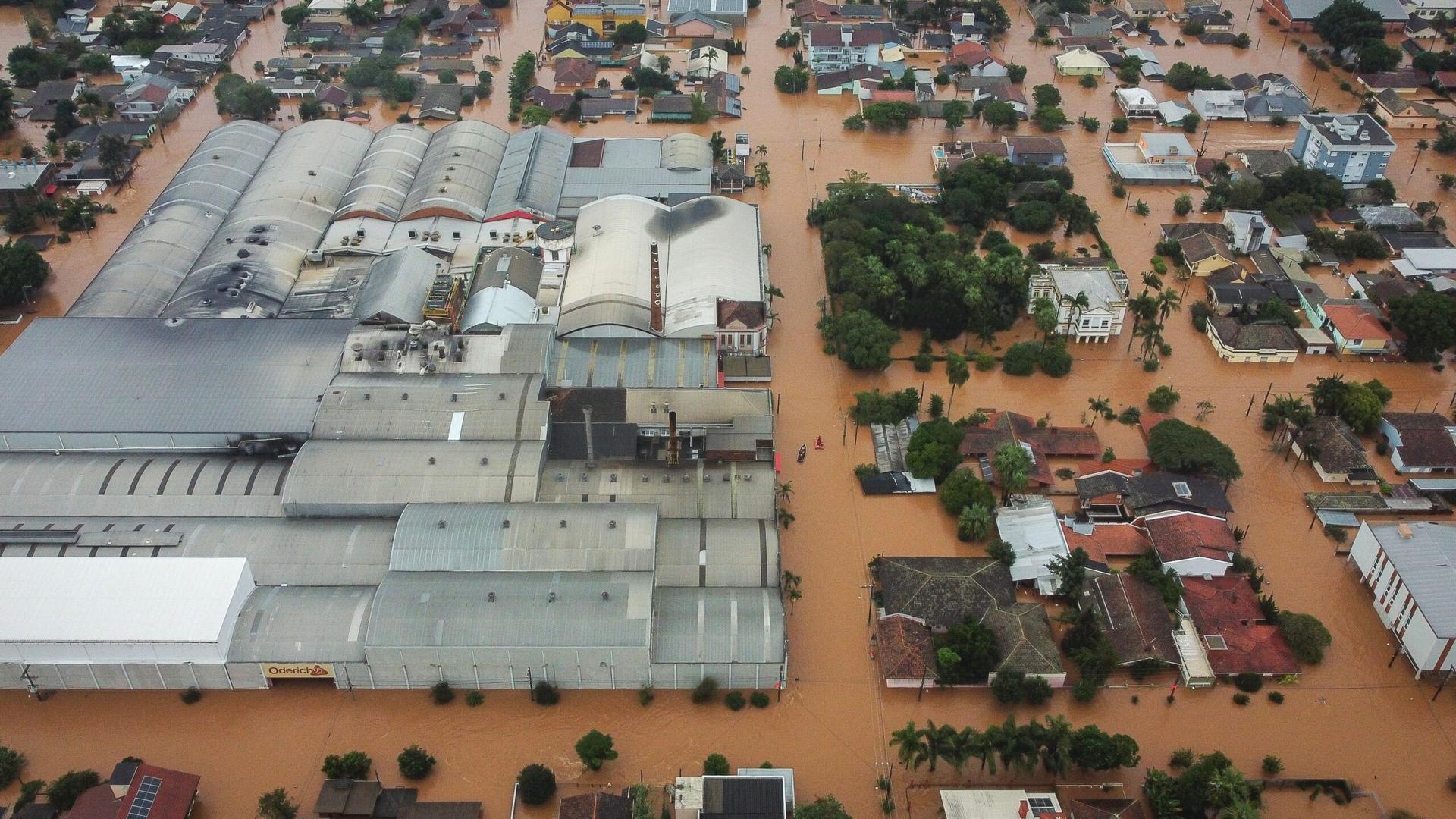Vagner Goulart, a lawyer from Novo Hamburgo, Brazil, said the flooding of the Guaíba River—a major body of water in the state of Rio Grande do Sul — is unlike anything he’s seen before.
“Rio Grande do Sul has never had a flood like this. Not since 1941. It’s terrible,” Goulart said.
A video shared online on Saturday night showed a human chain of dozens of people stretching into the flood waters in Canoas, Brazil, to help pull in a boat full of people plucked from rooftops.
That scene was repeated again and again over the weekend.
Right now, water levels in the Guaíba River are a foot and a half higher than they were during the 1941 flood. Thousands of people have lost their homes. Porto Alegre’s airport, Salgado Filho, is underwater and flights are expected to be canceled through the end of the month.

Emergency messages and sirens blared from loudspeakers in many neighborhoods in recent days as residents were ordered to flee, as rising flood waters breached dikes and poured into neighborhoods.
Since the beginning of the flooding disaster, 20,000 people have been rescued in Rio Grande do Sul — with many being rescued by local residents who have been using their own boats and jet skis.

Fabiano Saldanha is one of those residents helping. He was interviewed by a Brazilian media outlet over the weekend.
“I couldn’t sleep last night. Because, in my mind, I could only think of the people yelling, ‘Help, help, help. And they’ve lost everything. They don’t have anything left,” Saldanha told press. “It’s a war, but everyone is helping.”

Other residents can be found cutting cabbage at a makeshift community soup kitchen in the working-class neighborhood of Cruzeiro, organized by the state chapter of Levante Popular da Juventude, which means Youth Uprising social movement.
Usually, the group cooks to deliver food for neighbors in need. But now, they’re making hundreds of meals to deliver to those hit hardest by the floods — one of dozens of initiatives like this across the region.

“The key word right now is solidarity,” said Lucas Gertz Monteiro, who is coordinating the effort. “This has motivated the people here over the last few days.”
About 82% of the residents of the municipality of Sao Leopoldo, north of Porto Alegre, have been forced from their homes due to the floods. And almost 20,000 people are in shelters across the region right now.
Alexandre Zavascki is a doctor attending to people at one of the centers, a few blocks from downtown Porto Alegre, which is covered in water.

“The main thing I’m treating people for now are things like people have preexisting conditions, like diabetes and hypertension, and they’ve lost their medicine,” he said. “And also, there is a team for psychiatric care because people are impacted and traumatized with what has happened,” he said.
Countless videos online show people being rescued off of corrugated metal rooftops. Brown floodwaters swallowed the rest of the homes. In one video, a woman in a striped black and white shirt lays on a roof. She’s murmuring and barely able to move.
“I know, I know, ma’am,” reassures a rescue worker beside her who is trying to help her get into the helicopter. “But now we’re gonna get you outta here.”
Governor Eduardo Leite told press on Saturday night that they would need absurdly exceptional measures.
“Rio Grande do Sul is going to need a type of Marshall Plan of reconstruction. Something like the reconstruction plan for Europe after World War II.”
Eduardo Leite, governor of Rio Grande do Sul
“Rio Grande do Sul is going to need a type of Marshall Plan of reconstruction,” he said. “Something like the reconstruction plan for Europe after World War II.”
President Luiz Inácio Lula da Silva flew over the disaster on Sunday. He promised to rebuild roads and help free up necessary funds for the state. He’s also called for a plan to prevent a future disaster like this.
Environmentalists say the state’s relaxation of environmental legislation contributed to the tragedy by clearing forest land for agriculture that would have helped absorb excess runoff.

They also blame local officials for refusing to implement public policies that would have prepared the region for the disaster.
“Here in Porto Alegre, there were floodgates stuck because of a lack of maintenance. Pump houses, too. A few of them weren’t working. One or two bursts,” said biologist Paulo Brack, a professor at the Federal University of Rio Grande do Sul. “So, yes, there was a huge lack of preparation on the part of Porto Alegre’s City Hall. And unfortunately, there was no preparation for this event by the Porto Alegre municipal government or the Rio Grande do Sul state government.”
Experts say the water levels in Porto Alegre’s Guaíba River could remain above flood levels for the next 10 days. Meanwhile, 70% of residents in the region lack potable water.

Gustavo Türck, a local journalist with the community media outlet Coletivo Catarse, said his family has electricity and running water for now, but they are rationing.
“It’s only a matter of time before the water runs out, so we are filling up bottles,” he said. “We don’t know what to expect. We’ve never lived through anything like this, and it’s going to be a long time before the city rebounds from this tragedy.”
In the meantime, Brazilians everywhere are doing what they can to help.

Across the country, people are gathering donations. Dozens of people chipped in at one community effort last night in Florianópolis, about six hours from Porto Alegre. Residents packed mattresses, clothes, diapers, shoes and water into a truck already headed south.
It’s one small effort. But right now, this is all people can do: Help and pray for clear skies.
